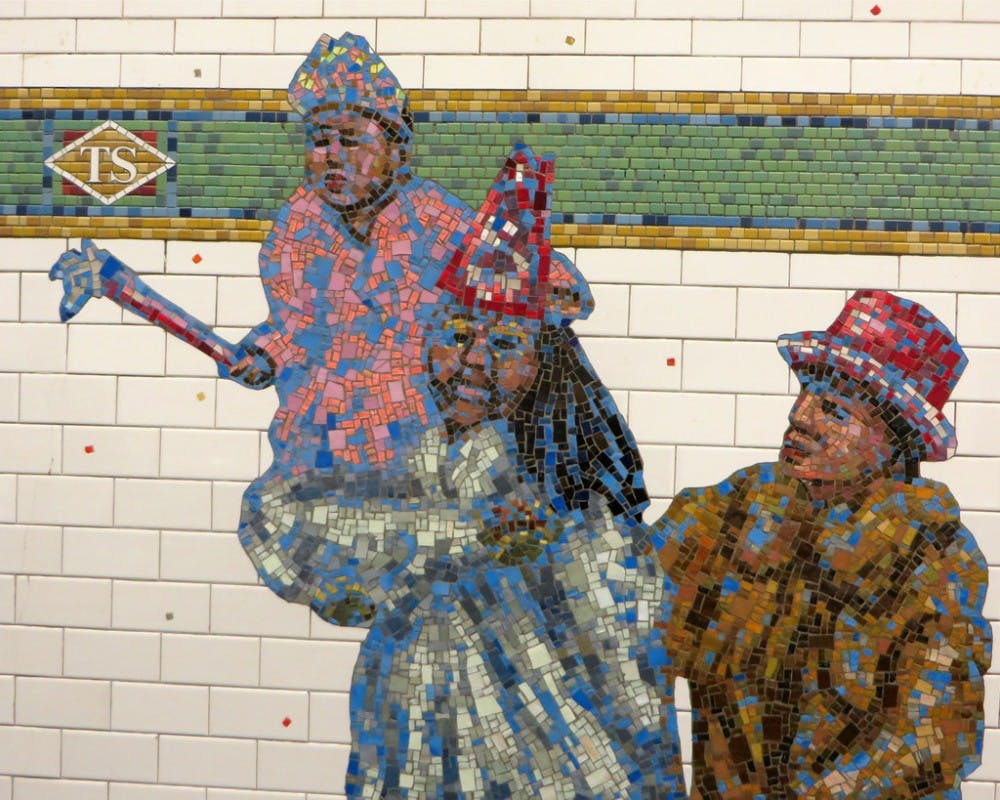By WILLIAM KIRSCH For The News-Letter
The Center for Visual Arts hosted Jane Dickson, a mixed-medium painter who has featured her work in some of the country’s most distinguished museums, as this fall’s visiting artist on Thursday. Dickson gave a short lecture regarding her work and its thematic and stylistic elements.
Center for Visual Arts Director Craig Hankin opened the talk, saying that he had only been familiar with Dickson’s work for a year but was blown away by her portfolio.
Hankin outlined the artist’s body of work: 40 solo exhibitions and 200 group shows with art on display in various museums such as the Metropolitan Museum of Art and The Whitney Museum. The Manhattan Transit Authority also selected Dickson to create a series of paintings of New Year’s Eve revelers on the walls of the 42nd Street and Times Square subway stations.
Much of Dickson’s work is dedicated to a sense of voyeurism, the practice of spying on people engaged in intimate, private behaviors. For instance, she depicts street scenes and paintings of strippers from the perspective of a “peek-booth.” Creating the latter pieces, the artist used sandpaper as her canvas, a decision she made in order to convey the “look-but-don’t-touch” mentality of strip clubs.
The voyeuristic theme of Dickson’s paintings can also be found in her studies of Coney Island — one of which is now a permanent street art piece — that are marked by a deep contrast between light and dark.
Dickson cultivated the motif of her work by moving away from outdoor or “plein-air” painting; instead, she frames her pieces within windows. Perhaps as a result of this, Dickson did a group painting inspired by Japanese styles, which made use of lengthy vertical canvases. While this style of art offers some limitations due to the restricted scenes, Dickson felt that it still aligned with the city’s layout.
“For the canyons of New York, it suddenly made sense,” Dickson said.
Dickson was a member of the New York-based artist’s group titled Collaborative Projects, which began in 1978, the year the artist herself moved to New York. Colab, as it was also known, hosted a series of themed shows, including the “Times Square Show,” the poster for which Dickson designed.
The artist’s origins in New York resulted from her assignment to work on the city’s first computer billboard. This job had a stylistic influence on Dickson, inspiring her to highlight the contrast between light and dark in her work. The artist created this contrast by painting the neon colors and bold lighting of ‘70s and ‘80s images of Times Square on mostly black and dark gray backgrounds.
Dickson’s Times Square paintings come from the days when the area was not a gaudy tourist destination but a seedy huddle of night life. The dangerous reality of the environment shows itself in Dickson’s work, especially in the aforementioned use of distinct shades and colors.
Nonetheless Dickson’s subject matter is not limited to New York City. The author also travelled to Las Vegas where she painted the gaudy interiors of casinos. In these pieces the artist shows people fixated on screens as a reflection on societal habits.
“I paint things to understand what I know,” she said.
This collection also bears the trademark contrast between colors: The vibrant fabrics and patterns of the casino with its flashing neon machines surround modestly dressed neutral figures. These contrast-driven paintings conflict with Dickson’s other series titled Demolition Derby, the inspiration for which the artist found while visiting Florida. The pieces of this series, which shows stripped-out and beaten-up cars smashing into one another, are much more hazy and ethereal; The colors mix amongst the dust kicked up by the cars.
In the vein of textural art, Dickson also created a group of paintings on Astroturf. Collectively called Heading Out, these works are landscape views of highways stretching out in the country. Dickson said that the Astroturf served to represent the sprawling nature lining the roads. Interestingly even these paintings are not depicted from a plein air perspective. Instead they are views from the inside of the car.
The artist also painted the opposite in Heading In which depicts cars on their way into the city. Dickson said that one of these works was inspired by the post-9/11 fear of “bridge or tunnel.” She said that at the time New Yorkers felt that they had to choose in location which they would rather die.
Dickson was modest and apologetic as she came toward the end of her lecture, assuring her audience that she was almost finished speaking. Despite the artist’s joking reticence the talk was an interesting look into the mindset of a significant contemporary artist. Dickson’s presence at Hopkins was a valuable break from the University’s constant association with medicine. It showed that this is a place that welcomes and promotes learning about art and its subtle and nuanced beauty.





